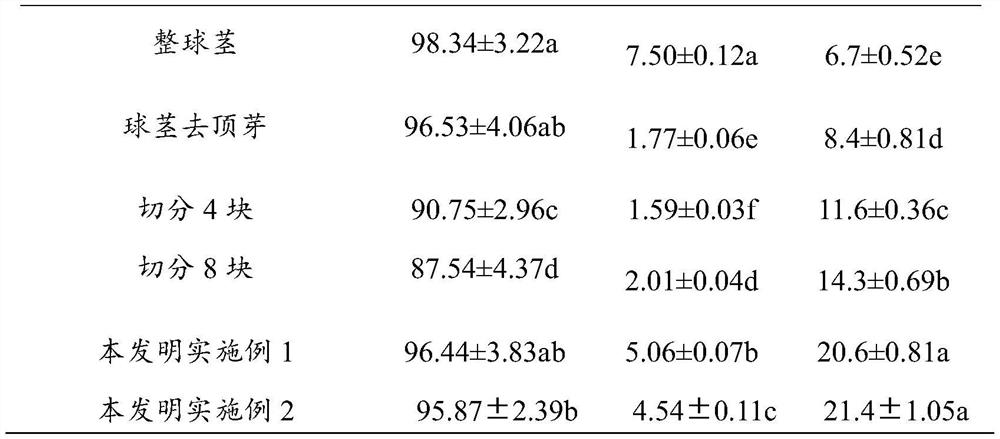Method for promoting sprouting of resting buds of konjac to fast produce taros
A latent bud, seed taro technology, applied in the direction of seed and rhizome treatment, application, root crop cultivation, etc., can solve the problems of inability to meet the demand for provenance, lack of disease-resistant varieties, and poor disease resistance.
- Summary
- Abstract
- Description
- Claims
- Application Information
AI Technical Summary
Problems solved by technology
Method used
Image
Examples
Embodiment 1
[0036] A method for promoting the germination of konjac latent buds to rapidly produce seed taro, comprising the following steps:
[0037] Step 1, screening of bulbs
[0038] Screen out the seed bulbs with a quality of 60-150g for subsequent use;
[0039] Step 2, seed bulb processing
[0040] Select sunny days for treatment at the end of September after the bulbs are harvested.
[0041] (1) Terminal bud treatment: wash and dry the bulbs, and then use a small iron spoon to dig out the entire terminal bud along the direction of the terminal bud nest. The depth of digging is 0.2-0.3cm; Potassium acid solution to disinfect the small iron spoon, soak and disinfect once every time you dig, soak for 20s.
[0042] (2) All the axillary buds inside the terminal bud nest and along the direction parallel to the top of the bud nest are removed, subject to the absence of axillary buds, that is, the thickness of the cut is 0.1-0.2 cm, and the stems at the bottom are collected for subseque...
Embodiment 2
[0059] A method for promoting the germination of konjac latent buds to rapidly produce seed taro, comprising the following steps:
[0060] Step 1, screening of bulbs
[0061] Screen out the seed bulbs with a quality of 150-250g for subsequent use;
[0062] Step 2, seed bulb processing
[0063] Select sunny days for treatment in early October after the bulbs are harvested.
[0064] (1) Terminal bud treatment: wash and dry the bulbs, and then use a small iron spoon to dig out the entire terminal bud along the direction of the terminal bud bud nest. The depth of digging is 0.3-0.5cm; Potassium acid solution to disinfect the small iron spoon, soak and disinfect once every time you dig, soak for 20s.
[0065] (2) Divide the corm into two along the direction parallel to the bottom of the terminal bud nest. The specific cross-cutting position is based on the bud scar at the base of the terminal bud on the cut surface of the lower part of the corm. The average thickness of the cut ...
Embodiment 3
[0081] A method for promoting the germination of konjac latent buds to quickly produce seed taro is basically the same as the method of embodiment 1, the difference is that in step 3 (1), the ridge width is 1.5m, the furrow width is 1m, the row spacing is 45cm, and the plant spacing is 30cm;
[0082] Bioreactor preparation: waste mushroom residue left after harvesting shiitake mushrooms + EM bacteria and Bacillus subtilis used in production are mixed at a mass ratio of 1:1 + crushed to 2-3cm dead leaves;
[0083] The specific stacking method of the bioreactor: apply hole application between the two rows of konjac in each ridge. The depth of the hole is consistent with the sowing depth of konjac. The average hole depth is 20cm, and the hole diameter is 15-17cm; Leaves, the mass ratio of the two is 2:1, followed by spraying the compounded bacterial agent suspension, the total concentration of bacteria is ≥10 6 cfu / mL, until the discarded fungus residue is wet; finally, cover wit...
PUM
| Property | Measurement | Unit |
|---|---|---|
| Thickness | aaaaa | aaaaa |
Abstract
Description
Claims
Application Information
 Login to View More
Login to View More - R&D
- Intellectual Property
- Life Sciences
- Materials
- Tech Scout
- Unparalleled Data Quality
- Higher Quality Content
- 60% Fewer Hallucinations
Browse by: Latest US Patents, China's latest patents, Technical Efficacy Thesaurus, Application Domain, Technology Topic, Popular Technical Reports.
© 2025 PatSnap. All rights reserved.Legal|Privacy policy|Modern Slavery Act Transparency Statement|Sitemap|About US| Contact US: help@patsnap.com



